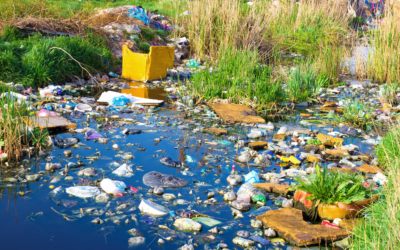There is an estimated 200 million tonnes of plastic in our oceans and at the current rate, ocean plastic pollution could increase by half as much again within the next 10 years [1]. Robust, harmonised regulation is critical to reducing both plastic production and ensuring the clean-up of plastics that have already entered our waterways.
Why we need more regulation on plastic pollution
The invention of plastic revolutionised our approach to product design and packaging. But consistent expansion in how and where we use plastics has led to sustained growth in the volume of plastics we produce. Half of human-generated waste is plastic and over 80% is single-use plastics destined to be thrown away after limited use. [2]
There are undoubtedly improvements that need to be made in how we dispose of and recycle plastics and a need to clean up our rivers and oceans to remove the plastic that is already polluting our environment. In the long term, the only truly effective long-term solution is to reduce production and eliminate unnecessary plastics. The less plastic that is produced; the less that is thrown away and the less that can leak into the environment.
Advocacy, awareness and strong policies are fundamental to driving a shift in how we design, produce and use plastic products, as well as stimulate a change in attitudes towards plastic as a throwaway product. This means robust regulation at all points in the plastic lifecycle. It also necessitates a range of regulatory solutions to deal wit the sheer range of products containing plastics from clothing to tyres and food packaging.
Approaches include:
- bans and restrictions directly prohibiting the production, importation or exportation, distribution, sale or use of one or more single-use plastic products;
- restrictions on the use of virgin plastic to reduce the amount of new material that is being used;
- economic measures, such as taxes, to deter production or use of single-use plastics or provide incentives to use alternatives;
- introduction of Extended Producer Responsibilities (EPRs) making producers responsible for collecting, recycling and reusing the plastic in their product, keeping the plastics that have already been produced in circulation for longer;
- introduction of Deposit Return Schemes to support the collection and reuse of plastic bottles and other items;
- requirements to collect and recycle a greater volume and different types of plastics, limiting the chance of plastic leaking into the environment; and
- requirements for cities and countries to take responsibility for their waterways, ensuring that the plastic that has leaked into the environment is removed and ongoing efforts are put in place to ensure they stay clean and plastic free.
Current Regulation Framework
European regulation
- Plastic strategy
In 2018, the European Commission published its plastic strategy to reduce single-use plastics, followed by legislation in the form of the Single-Use Plastics Directive. It bans many single-use items and mandates the use of sustainable alternatives where available, particularly for items commonly found on beaches and in riverine and marine litter such as cutlery, cotton buds, straws and bottles.
The strategy also included a pledge to make all plastic packaging available in the EU recyclable by 2030, a restriction on the intentional use of microplastics, e.g. small beads in health & beauty products, and a requirement for plastic drink bottles to contain at least 25% recycled plastic from 2025, increasing to 30% from 2030. [3]
The Directive seeks to improve recovery of other plastics, such as bottles, setting a target of 70% being collected and reused by 2025, rising to 90% by the end of the decade. This is unlikely to be possible without the introduction of deposit return schemes and EPRs. However, the legislation has stopped short of requiring these at a European level, leaving their introduction in the hands of individual member states meaning that implementation to date has been piecemeal.
The strategy was hailed at the time as the broadest-reaching regulatory action on plastics. [4] However, the focus on a defined list of single items many of which can be made from cellulose and other plastics not covered by the regulation, coupled with the lack of a common position on EPRs, means that it is far from a comprehensive solution to the problem. Individual countries, including France and Spain, have felt the need to go further and faster.
- Plastic taxes
Introduced at the start of 2021, the EU has levied a “plastic tax” (officially a budget contribution) on all unrecycled plastic waste generated within the region. Member states must pay €0.80 for every kilogram of waste; the amount of waste is calculated based on forecast data produced by Eurostat. Some member states intend to pay the contribution from their national budget, while others are planning to set up their own national plastic taxation systems, passing the cost on to companies that produce and use plastic. [5]
Again, individual states have felt the need to go further and faster. At the start of 2023, Spain imposed a tax of €450 per tonne on packaging using non-recycled plastic. The highest rate is charged on packaging containing less than 30% recycled material, decreasing the more recycled plastic is used. Italy has similar plans, but the implementation is currently on hold. Given the novelty of the regulation, it is currently difficult to say what the impact of this and similar restrictions in other countries will be.
- Extended Producer Responsibilities
Extended Producer Responsibility (EPR) works of the principle that the “polluter pays”, ensuring that producers are accountable for a product through to the end of life and pay for the responsible recovery, recycling or disposal. EPR schemes for packaging, including plastic packaging, are in place in almost all European countries, but the requirements placed on manufacturers via these schemes and the types of packaging covered differ significantly from country to country.
Germany, France and Belgium are considered frontrunners in the application of EPR, with Belgium reaching plastic recycling rates in excess of 50% – the EU plastics strategy targets to reach this level by 2025. [6] The European Commission is in the process of harmonising rules to ensure consistent application across Europe. [7]
The schemes are credited with having promoted better systems for separately collecting and recycling waste, but the variation in schemes across Europe creates confusion. The schemes have also encouraged a move to lighter-weight plastics that may be less recyclable rather than recyclable or reusable alternatives. [8]
The Netherlands
The Dutch Government has implemented a range of initiatives to restrict plastic use in line with European regulations. They include a ban on commonly used single-use items like cotton and EPRs to fund the collection and processing of waste items such as bags, takeaway packaging and drink cups and consumer education on the environmental impact of litter. [9] There has been little regulatory focus beyond plastic packaging, despite non-packaging accounting for more than 70% of plastic use. [10]
Other interventions
Countries across Europe have imposed other regulatory measures in a bid to reduce unnecessary use of single-use plastics. However, the variability between countries undermines their potential impact. [11]
| Application | Advantages | Disadvantages | |
| Plastic bag: charges | Most of Europe ex. Germany, Norway and Sweden | – Reduces plastic bag use by around 80% if consistently applied across all retailers – Encourages people to bring their own bags, esp. those who would otherwise forget – Fewer bags to collect reduces the cost of waste management – Revenue generated can be reinvested in clean-up or for social impact, e.g. John Lewis Foundation | – Plastic bags still produced – Option remains to buy a single-use bag rather than bring a reusable one |
| Plastic bag ban on manufacture/ import | Partial ban: Austria, France, Italy Netherlands | – Reduces retail prices, as the cost of a ‘free’ bag is no longer included in the price of goods – Fewer bags to collect reduces the cost of waste management R – Reduces infrastructure maintenance costs, as drains are no longer blocked by plastic bags – Increases tourism revenue in areas previously blighted by plastic pollution, esp. coastal regions – Stimulates growth of reprocessing sector and shift to circular economy, with associated job creation | – Multiple exemptions mean certain thickness of plastic bags still used – Plastic bags enter the market from abroad – Places onus on consumers to buy suitable reusable alternatives – Opponents suggest bag bans result in a drop in retail sales as consumers buy less – Job losses in the plastics industry due to reduce production |
| Food packaging | France: ban on plastic packaging for 30 types of fruit and vegetables Spain: ban on plastic packaging on all fruit and vegetables in packs weigh ≤1.5kg | – Reduces food waste, as consumers can buy what they need | – May increase food waste as some items have a shorter shelf life without packaging |
| Deposit return schemes | Croatia, Denmark, Estonia, Finland, Germany, Iceland, Lithuania, Netherlands, Norway, and Sweden | – Significantly boost return and recycling rates; up to 97% for PET bottles in Norway – Reduces the cost of litter collection – Provides fundraising opportunities for the voluntary sector, which collect in unreturned bottles – Stimulates growth of reprocessing sector and shift to circular economy, with associated job creation | – Typically only collects bottles for recycling not reuse |
What needs to change?
Implementation of plastic regulation across Europe has been piecemeal, resulting in significant variation between countries. Scale this up globally and the picture is even more varied. At best, this results in confusion among manufacturers as to what rules apply where; at worst, it creates loopholes that can be exploited. For example, manufacture of plastic bags may be banned, but their import still allowed, meaning plastics can still enter the market from abroad. Similarly, irresponsible companies may choose to export plastic waste to avoid the need to comply with local regulations on recycling.
International coordination of the type promised by the UN Treaty on plastic pollution is essential to standardise and harmonise the regulatory approach to plastics. However, as noted in our blog on the UN Plastic Treaty, negotiations are only just getting underway; a first draft of the treaty is not expected until at least November 2023. [12]
While the ultimate solution must be to reduce the production and use of plastics, particularly single-use items, there is already 200m tonnes of plastic waste in our oceans – an amount that increases by 11m tonnes a year, [13] much of which comes from rivers. However good any regulation, we will continue to use some plastics, allowing ongoing opportunity for plastic leakage. Consequently, it is imperative that we clean up our rivers at the same time as slowing plastic production. This requires cities, towns and communities to take ownership of their waterways, potentially supported by regulation to mandate clean-up operations.
Embracing circular policies such as those set out by the Circular City Actions Framework will also help. [14] They aim to shift how we uses resources and recover materials, ensuring that the value and utility of products, components, materials and nutrients is maintained for as long as possible. Amsterdam is a frontrunner in embracing circularity, and pilots are already underway in Gothenburg, Munich and elsewhere as part of the European Circular Cities and Regions Initiative. [15]
Author
Dr. Sarah Walkley
Sarah is a freelance copywriter specialising in sustainability topics and volunteers at The Great Bubble Barrier.
Picture: Volodymyr Hryshchenko
References
[1] Ocean Conservancy, 2022, The problem with plastics, available at: https://oceanconservancy.org/trash-free-seas/plastics-in-the-ocean/
[2] General Assembly of the United Nations, 2022, Making the United Nations relevant to all people: Plastics, available at: https://www.un.org/pga/73/plastics
[3] European Commission, 16 January 2018, Plastic Waste: A European strategy to protect the planet, defend our citizens and empower our industries, available at: https://ec.europa.eu/commission/presscorner/detail/en/IP_18_5
[4] AdaPETation, 6 July 2022, Global plastic regulations: Economics, packaging, sensemaking, available at: https://adapetation.net/global-plastic-regulations/
[5] KPMG, September 2021, Plastic Tax, available at: https://kpmg.com/xx/en/home/insights/2021/09/plastic-tax.html
[6] Packaging Europe, 1 March 2022, EPR: Penalty or Opportunity, available at: https://packagingeurope.com/comment/epr-penalty-or-opportunity/7929.article and AdaPETation, 6 July 2022, Global plastic regulations: Economics, packaging, sensemaking, available at: https://adapetation.net/global-plastic-regulations/
[7] Packaging Europe, 1 March 2022, EPR: Penalty or Opportunity, available at: https://packagingeurope.com/comment/epr-penalty-or-opportunity/7929.article
[8] Institute for European Environmental Policy, 9 November 2017, EPR in the EU Plastics Strategy and the Circular Economy: A focus on plastic packaging, available at: https://zerowasteeurope.eu/wp-content/uploads/2019/11/zero_waste_europe_IEEP_EEB_report_epr_and_plastics.pdf
[9] CMS, 30 Jun 2021, Plastics and packaging laws in The Netherlands, available at: https://cms.law/en/int/expert-guides/plastics-and-packaging-laws/the-netherlands
[10] European Environment Agency, 12 December 2022, Managing non-packaging plastics in European waste streams — the missing part of the plastic puzzle, available at: https://www.eea.europa.eu/publications/managing-non-packaging-plastics
[11] Muposhi, A., Mpinganjira, M. Wait, M. 2021, ‘Considerations, benefits and unintended consequences of banning plastic shopping bags for environmental sustainability: A systematic literature review’, Waste Management and Research, Vol. 40, available at: https://journals.sagepub.com/doi/pdf/10.1177/0734242X211003965 and DEFRA, 2021, Introducing a Deposit Return Scheme on beverage containers, available at: https://consult.defra.gov.uk/environment/consultation-on-introducing-a-drs/supporting_documents/Impact%20Assessment.pdf
[12] Volcovici, V., 5 June 2023, ‘After rough start, UN plastic treaty talks end with mandate for first draft’, Reuters, available at: https://www.reuters.com/business/environment/after-rough-start-un-plastic-treaty-talks-end-with-mandate-first-draft-2023-06-02/
[13] Ocean Conservancy, 2022, The problem with plastics, available at: https://oceanconservancy.org/trash-free-seas/plastics-in-the-ocean/
[14] ICLEI, 2021, Circular City Actions Framework, available at: https://circulars.iclei.org/action-framework/#:~:text=A%20circular%20city%20is%20one,businesses%20and%20the%20research%20community.
[15] European Commission, 2023, Circular Cities and Regions Initiative, available at: https://circular-cities-and-regions.ec.europa.eu/




